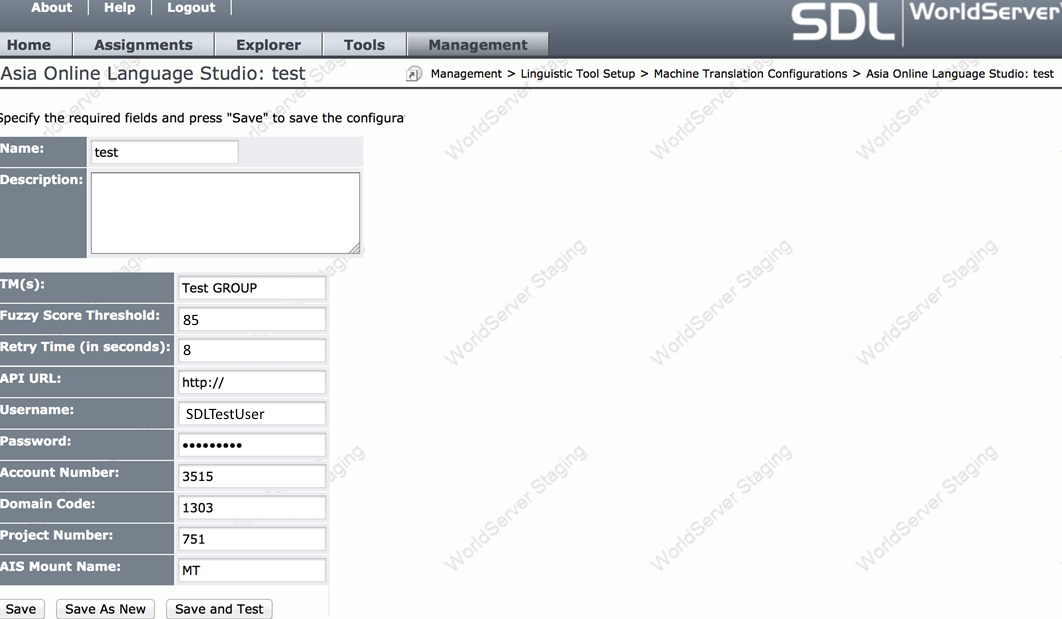Java Notes:
We have a WorldServer connector that is available for use. It requires Java 8 (http://www.oracle.com/technetwork/java/javase/downloads/jre8-downloads-2133155.html).
Some WorldServer environments are still Java 7, in which case both can be 7 and 8 can co-exist, but unfortunately we are not able to offer advice on the specific set up in such a dual version case as this is a Java specific issue that we have not personally configured.
You can find how to configure the Language Studio connector in WorldServer below.
Required Information:
You will need the following information:
- Your Language Studio™ Account Number, Username and Password.
Your account manager will provide this information to you when you first set up your account. You may also have received this email in an account activation email.
If you are able to log in, you can also see the information in the top right-corner of the Language Studio™ web portal user interface.
- The Domain Code of the engine that you want to translate with and the Language Studio™ Project ID to use.
The Domain Code is the unique ID of a custom engine that you will use to translate with. A list of Domain Codes and their associated custom engines can be found in the Custom Engine Catalog in the Language Studio™ web portal user interface.
The Project ID is the ID of Language Studio™ project that will be used to load configuration information for run-time rules and settings. A list of projects can be found on the Translation Projects menu in the Language Studio™ web portal user interface.
- The Language Studio™ Enterprise Server URL for the server that you are using.
If you are using Omniscien Technologies' hosted Language Studio SaaS environment then you should use the following URL:
https://api.languagestudio.com/DatasetReceiver.asmx
If you have an on-site or a dedicated hosted installation of Language Studio then you should specify the URL to your server.
Installing the SDL WorldServer for Language Studio™ Connector:
Open the Management > Administration >Customization menu and click Add to add the Language Studio™ connector.
After adding, the screen should look like below:

Adding a Machine Translation Configuration:
Open the Management > Linguistic Tool Setup > Machine Translation Configurations menu and select Language Studio.


- Name: The display name for the connection.
- Description: A longer description of the connection.
- TM(s): The TM or TM group that will be leveraged against by the machine translation adapter to identify segments that is beyond the Fuzzy Score Threshold. This should be the same as the project type TM setting or AIS TM setting. If a single TM is used, then simply use the TM name instead of a TM group name. The parameter takes a single value (either one TM name or one TM group name).
- Fuzzy Score Threshold: The threshold for target segments that will not be considered for machine translation if there is a fuzzy match equal or greater to the configured value.
- Retry Time: The number of seconds between checking the status of a job processing. Once a job status changes to Complete, Error or cancelled, the job will be considered complete by SDL WorldServer. If the status is Complete then the target segments will be populated with the machine translation results.
- API URL: Is the Language Studio™ Cloud URL as described above.
- Username, Password, and Account Number: User credentials as described above.
- Domain Code: The Language Studio™ Domain Code for an engine as described above.
- Project Number: The Language Studio™ Project Number for configuration settings as described above.
- AIS Mount Name: The path for saving the log files and translated target files. Set folder the way you make any other AIS mount directory. The translated files from Language Studio™ will be deleted after it is processed successfully.
